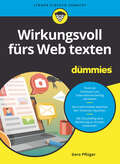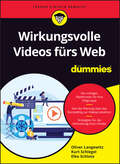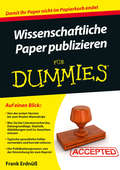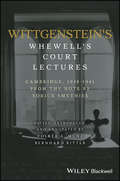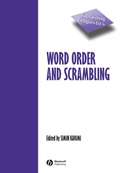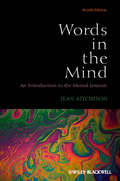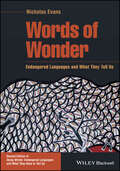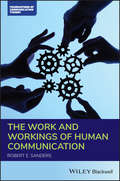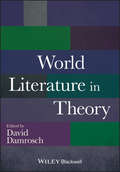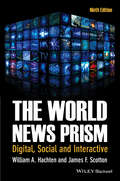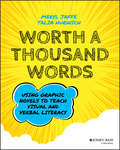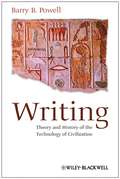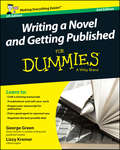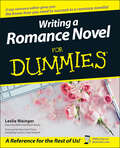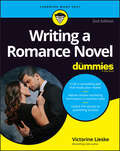- Table View
- List View
Wirkungsvoll fürs Web texten für Dummies (Für Dummies)
by Gero PflugerSie haben eine Website und möchten in Texten Informationen über Produkte oder Dienstleistungen liefern? Sie verkaufen übers Internet und brauchen knackige Produktbeschreibungen? Oder ist Ihr tägliches Brot das Schreiben von Online-Pressemitteilungen, E-Mail-Newslettern oder Social-Media-Beiträgen? Dieses Buch unterstützt Sie dabei, bessere Texte für Ihre Online-Auftritte zu produzieren, damit diese für Ihre Besucher und Follower relevanter werden. Lernen Sie Texten: Es ist gar nicht so schwer.
Wirkungsvolle Videos fürs Web für Dummies (Für Dummies)
by Oliver Langewitz Kurt Schlegel Elke SchloteMithilfe von Videos das Netz begeistern Videos bieten Ihnen die Möglichkeit, eigene Ideen zu vermitteln oder Ihre Marke zu präsentieren. Wie Sie wirkungsvolle Videos fürs Web erstellen und was Sie bei der videobasierten Kommunikation beachten müssen, erfahren Sie in diesem Buch. Oliver Langewitz, Kurt Schlegel und Elke Schlote erklären Ihnen in praktischen Schritten, wie Ihnen die Planung, Erstellung und Verbreitung von Videos fürs Web optimal gelingt. Dabei lernen Sie auch die Besonderheiten der verschiedenen Internetplattformen kennen und wie Sie Ihre Zielgruppe mit Ihren Inhalten abholen. Sie erfahren Wie Sie professionelle Webvideos produzieren Wie Sie in Ihren Videos wirksame Geschichten erzählen Welche Online-Kanäle für Ihre Videos wichtig sind Wie es Ihnen gelingt, mit Ihren Videos eine breite Community zu erreichen
Wissenschaftliche Paper publizieren für Dummies (Für Dummies)
by Frank ErdnüssEs ist soweit: Sie haben endlose Zeit im Labor, Feld oder über Literaturbergen verbracht und nun ist es an der Zeit, Ihre Erkenntnisse der wissenschaftlichen Gemeinschaft mitzuteilen; kurzum Sie müssen oder wollen in einer Fachzeitschrift publizieren. Dabei gibt es einiges zu beachten und meist ist die Zeit auch noch knapp. Aber keine Sorge, Frank Erdnüß hat für Sie kurz alles Wichtige zusammengestellt, was es bei einer wissenschaftlichen Veröffentlichung zu beachten gibt. Egal ob es Ihr erstes Paper ist oder ob Sie schon Publikationserfahrung haben; Sie erhalten Tipps zur Auswahl des richtigen Journals, zu Statistik, Literaturverwaltung, Grafiken, Zitierweisen, Wissenschaftsenglisch und vielem mehr. Dieses praxisnahe Buch begleitet Sie über die gesamte Manuskripterstellung und den Publikationsprozess hinweg, bis es schließlich heißt: Paper accepted.
Wittgenstein's Whewell's Court Lectures: Cambridge, 1938 - 1941, From the Notes by Yorick Smythies
by Yorick SmythiesWittgenstein’s Whewell’s Court Lectures contains previously unpublished notes from lectures given by Ludwig Wittgenstein between 1938 and 1941. The volume offers new insight into the development of Wittgenstein’s thought and includes some of the finest examples of Wittgenstein’s lectures in regard to both content and reliability. Many notes in this text refer to lectures from which no other detailed notes survive, offering new contexts to Wittgenstein’s examples and metaphors, and providing a more thorough and systematic treatment of many topics Each set of notes is accompanied by an editorial introduction, a physical description and dating of the notes, and a summary of their relation to Wittgenstein’s Nachlass Offers new insight into the development of Wittgenstein’s ideas, in particular his ideas about certainty and concept-formation The lectures include more than 70 illustrations of blackboard drawings, which underline the importance of visual thought in Wittgenstein’s approach to philosophy Challenges the dating of some already published lecture notes, including the Lectures on Freedom of the Will and the Lectures on Religious Belief
Wittgenstein's Whewell's Court Lectures: Cambridge, 1938 - 1941, From the Notes by Yorick Smythies
by Yorick SmythiesWittgenstein’s Whewell’s Court Lectures contains previously unpublished notes from lectures given by Ludwig Wittgenstein between 1938 and 1941. The volume offers new insight into the development of Wittgenstein’s thought and includes some of the finest examples of Wittgenstein’s lectures in regard to both content and reliability. Many notes in this text refer to lectures from which no other detailed notes survive, offering new contexts to Wittgenstein’s examples and metaphors, and providing a more thorough and systematic treatment of many topics Each set of notes is accompanied by an editorial introduction, a physical description and dating of the notes, and a summary of their relation to Wittgenstein’s Nachlass Offers new insight into the development of Wittgenstein’s ideas, in particular his ideas about certainty and concept-formation The lectures include more than 70 illustrations of blackboard drawings, which underline the importance of visual thought in Wittgenstein’s approach to philosophy Challenges the dating of some already published lecture notes, including the Lectures on Freedom of the Will and the Lectures on Religious Belief
Word Order and Scrambling (Explaining Linguistics #4)
by Simin KarimiWord Order and Scrambling introduces readers to recent research into the linguistic phenomenon called scrambling and is a valuable contribution to the fields of theoretical linguistics, psycholinguistics, and applied linguistics. Introduces readers to recent research into the linguistic phenomenon called scrambling, or free word order. Explores major issues including factors responsible for word order variations, how scrambled constructions are processed, and whether variations are available in early child language development and in second language acquisition. Discusses a number of typologically diverse languages including Hindi, Japanese, and Navajo. Provides enlightening information on different aspects of word order variation and the consequences for our understanding of the nature of human language.
Words in the Mind: An Introduction to the Mental Lexicon (Konzepte Der Sprach- Und Literaturwissenschaft Ser.)
by Jean AitchisonFeaturing new coverage of the brain and language, and lexical corpora, the 4th edition of Words in the Mind offers readers the latest thinking about the ways in which we learn words, remember them, understand them, and find the ones we want to use. Explores the latest insights into the complex relationship between language, words, and the human mind, creating a rich and revealing resource for students and non-specialists alike Addresses the structure and content of the human word-store – the ‘mental lexicon’ – with particular reference to the spoken language of native English speakers Features a wealth of new material, including an all-new chapter focusing exclusively on the brain and language, and enhanced coverage of lexical corpora – computerized databases – and on lexical change of meaning Incorporates numerous updates throughout, including expansion of many notes and suggestions for further reading Comprises state-of-the-art research, yet remains accessible and student-friendly
Words in the Mind: An Introduction to the Mental Lexicon
by Jean AitchisonFeaturing new coverage of the brain and language, and lexical corpora, the 4th edition of Words in the Mind offers readers the latest thinking about the ways in which we learn words, remember them, understand them, and find the ones we want to use. Explores the latest insights into the complex relationship between language, words, and the human mind, creating a rich and revealing resource for students and non-specialists alike Addresses the structure and content of the human word-store – the ‘mental lexicon’ – with particular reference to the spoken language of native English speakers Features a wealth of new material, including an all-new chapter focusing exclusively on the brain and language, and enhanced coverage of lexical corpora – computerized databases – and on lexical change of meaning Incorporates numerous updates throughout, including expansion of many notes and suggestions for further reading Comprises state-of-the-art research, yet remains accessible and student-friendly
Words of Wonder: Endangered Languages and What They Tell Us (The Language Library)
by Nicholas EvansA gripping and moving text which explores the wealth of human language diversity, how deeply it matters, and how we can best turn the tide of language endangerment In the new, thoroughly revised second edition of Words of Wonder: Endangered Languages and What They Tell Us, Second Edition (formerly called Dying Words: Endangered Languages and What They Have to Tell Us), renowned scholar Nicholas Evans delivers an accessible and incisive text covering the impact of mass language endangerment. The distinguished author explores issues surrounding the preservation of indigenous languages, including the best and most effective ways to respond to the challenge of recording and documenting fragile oral traditions while they’re still with us. This latest edition offers an entirely new chapter on new developments in language revitalisation, including the impact of technology on language archiving, the use of social media, and autodocumentation by speakers. It also includes a number of new sections on how recent developments in language documentation give us a fuller picture of human linguistic diversity. Seeking to answer the question of why widespread linguistic diversity exists in the first place, the book weaves in portraits of individual “last speakers” and anecdotes about linguists and their discoveries. It provides access to a companion website with sound files and embedded video clips of various languages mentioned in the text. It also offers: A thorough introduction to the astonishing diversity of the world’s languages Comprehensive exploration of how the study of living languages can help us understand deep human history, including the decipherment of unknown texts in ancient languages Discussions of the intertwining of language, culture and thought, including both fieldwork and experimental studies An introduction to the dazzling beauty and variety of oral literature across a range of endangered languages In-depth examinations of the transformative effect of new technology on language documentation and revitalisation Perfect for undergraduate and graduate students studying language endangerment and preservation and for any reader who wants to discover what the full diversity of the world’s languages has to teach us, Words of Wonder: Endangered Languages and What They Tell Us, Second Edition, will earn a place in the libraries of linguistics, anthropology, and sociology scholars with a professional or personal interest in endangered languages and in the full wealth of the world’s languages.
Words of Wonder: Endangered Languages and What They Tell Us (The Language Library)
by Nicholas EvansA gripping and moving text which explores the wealth of human language diversity, how deeply it matters, and how we can best turn the tide of language endangerment In the new, thoroughly revised second edition of Words of Wonder: Endangered Languages and What They Tell Us, Second Edition (formerly called Dying Words: Endangered Languages and What They Have to Tell Us), renowned scholar Nicholas Evans delivers an accessible and incisive text covering the impact of mass language endangerment. The distinguished author explores issues surrounding the preservation of indigenous languages, including the best and most effective ways to respond to the challenge of recording and documenting fragile oral traditions while they’re still with us. This latest edition offers an entirely new chapter on new developments in language revitalisation, including the impact of technology on language archiving, the use of social media, and autodocumentation by speakers. It also includes a number of new sections on how recent developments in language documentation give us a fuller picture of human linguistic diversity. Seeking to answer the question of why widespread linguistic diversity exists in the first place, the book weaves in portraits of individual “last speakers” and anecdotes about linguists and their discoveries. It provides access to a companion website with sound files and embedded video clips of various languages mentioned in the text. It also offers: A thorough introduction to the astonishing diversity of the world’s languages Comprehensive exploration of how the study of living languages can help us understand deep human history, including the decipherment of unknown texts in ancient languages Discussions of the intertwining of language, culture and thought, including both fieldwork and experimental studies An introduction to the dazzling beauty and variety of oral literature across a range of endangered languages In-depth examinations of the transformative effect of new technology on language documentation and revitalisation Perfect for undergraduate and graduate students studying language endangerment and preservation and for any reader who wants to discover what the full diversity of the world’s languages has to teach us, Words of Wonder: Endangered Languages and What They Tell Us, Second Edition, will earn a place in the libraries of linguistics, anthropology, and sociology scholars with a professional or personal interest in endangered languages and in the full wealth of the world’s languages.
The Work and Workings of Human Communication (Foundations of Communication Theory Series)
by Robert E. SandersDiscover the fundamentals of human communication with this comprehensive and insightful resource Written in four sections, The Work and Workings of Human Communication identifies the underlying fundamentals that make our communication distinctively human. These fundamentals are the common ground that tie together the many topics and subject matters covered by the study and discipline of communication. They are also the basis of the unique contribution of the communication discipline to the social sciences. Professor, researcher and theorist Robert E. Sanders starts by focusing on what is unique about human communication and moves on to an examination of the complexities of scientific inquiry in the social sciences in general and in the communication discipline specifically. At the heart of the matter is the fact that humans are thinking beings who can make choices and therefore are not entirely predictable. This points towards new topics and questions that are likely to arise as the discipline evolves. Sanders’ approach leads to recognition of the fact that communication is at the center of how humans build our ways of life and participate together. By focusing on the underlying fundamentals that give rise to the discipline’s topics and subject areas, The Work and Workings of Human Communication encourages students to engage in independent thought about what they want to contribute by: Emphasizing the importance of communication in creating, sustaining or changing—and participating in—our ways of life on an interpersonal level and on a societal level Recognizing that human communication is inherently collaborative; people affect situations by interacting with others, not acting on others Explaining the history, current agendas and possible future of the social science side of the Communication discipline A perfect resource for new graduate students in introductory communication courses who have an interest in the social science side of the discipline, The Work and Workings of Human Communication is also highly valuable for undergraduate communication and liberal arts students who don’t possess a background in the discipline.
The Work and Workings of Human Communication (Foundations of Communication Theory Series)
by Robert E. SandersDiscover the fundamentals of human communication with this comprehensive and insightful resource Written in four sections, The Work and Workings of Human Communication identifies the underlying fundamentals that make our communication distinctively human. These fundamentals are the common ground that tie together the many topics and subject matters covered by the study and discipline of communication. They are also the basis of the unique contribution of the communication discipline to the social sciences. Professor, researcher and theorist Robert E. Sanders starts by focusing on what is unique about human communication and moves on to an examination of the complexities of scientific inquiry in the social sciences in general and in the communication discipline specifically. At the heart of the matter is the fact that humans are thinking beings who can make choices and therefore are not entirely predictable. This points towards new topics and questions that are likely to arise as the discipline evolves. Sanders’ approach leads to recognition of the fact that communication is at the center of how humans build our ways of life and participate together. By focusing on the underlying fundamentals that give rise to the discipline’s topics and subject areas, The Work and Workings of Human Communication encourages students to engage in independent thought about what they want to contribute by: Emphasizing the importance of communication in creating, sustaining or changing—and participating in—our ways of life on an interpersonal level and on a societal level Recognizing that human communication is inherently collaborative; people affect situations by interacting with others, not acting on others Explaining the history, current agendas and possible future of the social science side of the Communication discipline A perfect resource for new graduate students in introductory communication courses who have an interest in the social science side of the discipline, The Work and Workings of Human Communication is also highly valuable for undergraduate communication and liberal arts students who don’t possess a background in the discipline.
World Literature in Theory
by David DamroschWorld Literature in Theory provides a definitive exploration of the pressing questions facing those studying world literature today. Coverage is split into four parts which examine the origins and seminal formulations of world literature, world literature in the age of globalization, contemporary debates on world literature, and localized versions of world literature Contains more than 30 important theoretical essays by the most influential scholars, including Johann Wolfgang von Goethe, Hugo Meltzl, Edward Said, Franco Moretti, Jorge Luis Borges, and Gayatri Spivak Includes substantive introductions to each essay, as well as an annotated bibliography for further reading Allows students to understand, articulate, and debate the most important issues in this rapidly changing field of study
World Literature in Theory
by David DamroschWorld Literature in Theory provides a definitive exploration of the pressing questions facing those studying world literature today. Coverage is split into four parts which examine the origins and seminal formulations of world literature, world literature in the age of globalization, contemporary debates on world literature, and localized versions of world literature Contains more than 30 important theoretical essays by the most influential scholars, including Johann Wolfgang von Goethe, Hugo Meltzl, Edward Said, Franco Moretti, Jorge Luis Borges, and Gayatri Spivak Includes substantive introductions to each essay, as well as an annotated bibliography for further reading Allows students to understand, articulate, and debate the most important issues in this rapidly changing field of study
The World News Prism: Digital, Social and Interactive
by William A. Hachten James F. ScottonNow available in a fully revised and updated ninth edition, World News Prism provides in-depth analysis of the changing role of transnational news media in the 21st-century. Includes three new chapters on Russia, Brazil, and India and a revised chapter on the Middle East written by regional media experts Features comprehensive coverage of the growing impact of social media on how news is being reported and received Charts the media revolutions occurring throughout the world and examines their effects both locally and globally Surveys the latest developments in new media and forecasts future developments
The World News Prism: Digital, Social and Interactive
by William A. Hachten James F. ScottonNow available in a fully revised and updated ninth edition, World News Prism provides in-depth analysis of the changing role of transnational news media in the 21st-century. Includes three new chapters on Russia, Brazil, and India and a revised chapter on the Middle East written by regional media experts Features comprehensive coverage of the growing impact of social media on how news is being reported and received Charts the media revolutions occurring throughout the world and examines their effects both locally and globally Surveys the latest developments in new media and forecasts future developments
Worth A Thousand Words: Using Graphic Novels to Teach Visual and Verbal Literacy
by Meryl Jaffe Talia HurwichUse graphic novels to teach visual and verbal literacy While our kids today are communicating outside the classroom in abbreviated text bursts with visual icons, teachers are required to teach them to critically listen, think, and read and write complex texts. Graphic novels are a uniquely poised vehicle we can use to bridge this dissonance between student communication skills and preferences with mandated educational goals. Worth a Thousand Words details how and why graphic novels are complex texts with advanced-level vocabulary, and demonstrates how to read and analyze these texts. It includes practical advice on how to integrate these books into both ELA and content-area classrooms and provides an extensive list of appropriate graphic novels for K-8 students, lesson suggestions, paired graphic/prose reading suggestions, and additional resources for taking these texts further. Provides research to back up why graphic novels are such powerful educational tools Helps you engage diverse student learners with exciting texts Shows you how to make lessons more meaningful Offers advice on implementing new literary mediums into your classroom Perfect for parents and teachers in grades K-8, Worth a Thousand Words opens up an exciting new world for teaching children visual and verbal literacy.
Worth A Thousand Words: Using Graphic Novels to Teach Visual and Verbal Literacy
by Meryl Jaffe Talia HurwichUse graphic novels to teach visual and verbal literacy While our kids today are communicating outside the classroom in abbreviated text bursts with visual icons, teachers are required to teach them to critically listen, think, and read and write complex texts. Graphic novels are a uniquely poised vehicle we can use to bridge this dissonance between student communication skills and preferences with mandated educational goals. Worth a Thousand Words details how and why graphic novels are complex texts with advanced-level vocabulary, and demonstrates how to read and analyze these texts. It includes practical advice on how to integrate these books into both ELA and content-area classrooms and provides an extensive list of appropriate graphic novels for K-8 students, lesson suggestions, paired graphic/prose reading suggestions, and additional resources for taking these texts further. Provides research to back up why graphic novels are such powerful educational tools Helps you engage diverse student learners with exciting texts Shows you how to make lessons more meaningful Offers advice on implementing new literary mediums into your classroom Perfect for parents and teachers in grades K-8, Worth a Thousand Words opens up an exciting new world for teaching children visual and verbal literacy.
Writing: Theory and History of the Technology of Civilization
by Barry B. PowellWriting: Theory and History of the Technology of Civilization traces the origins of writing tied to speech from ancient Sumer through the Greek alphabet and beyond. Examines the earliest evidence for writing in Mesopotamia in the fourth millennium BC, the origins of purely phonographic systems, and the mystery of alphabetic writing Includes discussions of Ancient Egyptian,Chinese, and Mayan writing Shows how the structures of writing served and do serve social needs and in turn create patterns of social behavior Clarifies the argument with many illustrations
Writing: Theory and History of the Technology of Civilization
by Barry B. PowellWriting: Theory and History of the Technology of Civilization traces the origins of writing tied to speech from ancient Sumer through the Greek alphabet and beyond. Examines the earliest evidence for writing in Mesopotamia in the fourth millennium BC, the origins of purely phonographic systems, and the mystery of alphabetic writing Includes discussions of Ancient Egyptian,Chinese, and Mayan writing Shows how the structures of writing served and do serve social needs and in turn create patterns of social behavior Clarifies the argument with many illustrations
Writing a Novel and Getting Published For Dummies UK
by George Green Lizzy E. KremerLearn to: Craft a winning manuscript Troubleshoot and edit your work Prepare your manuscript for publication Find a good agent to represent you Negotiate the best possible deal Turn your aspiration into reality with this completely updated guide If you’ve always wanted to write that great novel, but never knew where to start, look no further! With a published author advising you on how to write well and a literary agent providing insight into getting a publishing deal, this updated guide gives you the inside track on the art and science of breaking into the fiction-publishing industry. Taking you step by step from concept to contract, this book provides the tools you need to tell your story with skill and approach agents and publishers with confidence. Dive in — check out how to combine your natural talent with the writing techniques used by successful authors Establish a firm foundation — construct your basic story, plot and structure Examine the key elements — create characters, develop dialogue, explore relationships and insert conflict Fine-tune and finish up — discover tips on adding detail, creativity and flair while bringing your work to a close Get published — take the next step by weighing up your publishing options, working with agents and negotiating deals Find out more — check out additional advice, like the most common mistakes you need to avoid, and tips from published authors Open the book and find: Tips for getting started Creative ways to develop plots, storylines, characters and dialogue The seven basic stories and how to put them to work Tricks for crafting a great ending to your novel How to prepare your manuscript for editing and publishing The lowdown on the business side of publishing
Writing a Novel and Getting Published For Dummies UK
by George Green Lizzy E. KremerLearn to: Craft a winning manuscript Troubleshoot and edit your work Prepare your manuscript for publication Find a good agent to represent you Negotiate the best possible deal Turn your aspiration into reality with this completely updated guide If you’ve always wanted to write that great novel, but never knew where to start, look no further! With a published author advising you on how to write well and a literary agent providing insight into getting a publishing deal, this updated guide gives you the inside track on the art and science of breaking into the fiction-publishing industry. Taking you step by step from concept to contract, this book provides the tools you need to tell your story with skill and approach agents and publishers with confidence. Dive in — check out how to combine your natural talent with the writing techniques used by successful authors Establish a firm foundation — construct your basic story, plot and structure Examine the key elements — create characters, develop dialogue, explore relationships and insert conflict Fine-tune and finish up — discover tips on adding detail, creativity and flair while bringing your work to a close Get published — take the next step by weighing up your publishing options, working with agents and negotiating deals Find out more — check out additional advice, like the most common mistakes you need to avoid, and tips from published authors Open the book and find: Tips for getting started Creative ways to develop plots, storylines, characters and dialogue The seven basic stories and how to put them to work Tricks for crafting a great ending to your novel How to prepare your manuscript for editing and publishing The lowdown on the business side of publishing
Writing a Romance Novel For Dummies
by Leslie WaingerIn love with romance novels? You’re not alone! Romance is today’s most popular fiction genre, accounting for more than half of all mass market fiction sold. If you’re looking to make a serious effort at writing a romance and getting it published in today’s multifaceted markets, you need to learn as much as you can about this highly successful field—especially how to create the perfect heroes and heroines. Now, in this easy, step-by-step guide, a top romance editor gives you the know-how you need to succeed as a romance novelist! Writing A Romance Novel For Dummies is perfect for both beginning and more accomplished writers who are looking to get the leading edge on writing a romance novel and get it published. Leslie Wainger, Executive Editor at Harlequin Books, explains what it takes to become the next Nora Roberts, providing the techniques you need to: Select a pseudonym Write a compelling, heartfelt story Find the right agent and publisher Submit a manuscript Market your novel Join clubs and associations Packed with insider advice, this plain-English guide helps you grasp the building blocks of a great romance, providing practical tips on the craft of writing as well as savvy pointers on how to hook your reader from page one, write with passion, and shape a proposal that will wow agents and editors. You get lots of expert tips on analyzing the marketplace, creating compelling characters, and finding your own voice. Wainger also: Demystifies the sub-genres of the romance world, from historical, contemporary, and multicultural to paranormal, romantic suspense, and Christian/inspirational Explains plotting, pacing, and writing those crucial love scenes Discusses how to conduct research, assign credits, and get permissions Helps you decide whether it’s best to write alone or with a partner Complete with a manuscript preparation checklist, tips for revising your work smoothly and successfully, guidance in understanding and negotiating a contract, and a list of romance writing resources, Writing A Romance Novel For Dummies is your one-stop guide to becoming a published novelist!
Writing a Romance Novel For Dummies
by Leslie Wainger Victorine LieskeGet your romance (writing) on! Writing a Romance Novel For Dummies is the only reference aspiring writers need to get their careers off to the right start. Fully updated to reflect the industry's latest trends and secrets, this book helps you understand what makes a great novel, so you can hone your craft and write books people want to read. We break down the romance subgenres, give you expert tips on plotting and pacing, and walk you through the process of finding an agent and getting published in today’s competitive market—or self-publishing like many six-figure authors are doing. For aspiring writers longing to find success in the industry, Writing a Romance Novel For Dummies is easy to read, highly informative, and a must-have! Refine your writing to craft engaging stories readers can’t put down Find a route to publication that works for you—mainstream, or self-published Understand the ins and outs of the romance genre and its subgenres Learn how to get your work noticed in the popular world of romantic fiction This Dummies guide is perfect for beginning writers who want advice on writing and publishing a successful romance novel. It’s also a great reference for accomplished writers looking to level up their romance game.
Writing a Romance Novel For Dummies
by Leslie Wainger Victorine LieskeGet your romance (writing) on! Writing a Romance Novel For Dummies is the only reference aspiring writers need to get their careers off to the right start. Fully updated to reflect the industry's latest trends and secrets, this book helps you understand what makes a great novel, so you can hone your craft and write books people want to read. We break down the romance subgenres, give you expert tips on plotting and pacing, and walk you through the process of finding an agent and getting published in today’s competitive market—or self-publishing like many six-figure authors are doing. For aspiring writers longing to find success in the industry, Writing a Romance Novel For Dummies is easy to read, highly informative, and a must-have! Refine your writing to craft engaging stories readers can’t put down Find a route to publication that works for you—mainstream, or self-published Understand the ins and outs of the romance genre and its subgenres Learn how to get your work noticed in the popular world of romantic fiction This Dummies guide is perfect for beginning writers who want advice on writing and publishing a successful romance novel. It’s also a great reference for accomplished writers looking to level up their romance game.
